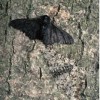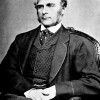
Nathan K. Hensley and John Patrick James, “Soot Moth: Biston Betularia and the Victorian End of Nature”
The darkened form of the common peppered moth, biston betularia f. carbonaria, known colloquially as the “soot moth,” was virtually unknown in England prior to 1800. The first reliable field specimen was collected outside of Manchester in 1848, plucked from the heart of Victorian England’s rapidly expanding coal economy. With their black abdomen and wings, these darkened morphs contrasted starkly with what had once been the more frequent form: a white-bodied moth lightly speckled with black and brown. As scientific studies now show, the black morph appeared as a result of industrial manufacture, first around major production centers and later around London. This article traces those studies to argue that the emergence of this particular form of melanistic moth signals a sharp pivot in Britain’s environmental history: its appearance augurs a new fossil modernity, in which coal replaces wood and animal fats as the primary source of English energy, and as stored sunlight, archived as coal, takes center stage as the driver for an endless steam-powered project of worldmaking. Tracing studies of “industrial melanism” to its origins at the beginning of this extractive, fossil-fueled modernity helps us see the soot moth’s emergence as a watershed moment in the history of life and a new chapter in humankind’s relationship to the category of nature.

Rebecca N. Mitchell, “Francis Galton’s Hereditary Genius, 1869 & 1892″
Francis Galton’s Hereditary Genius (1869, reissued 1892) claimed to be the first statistical study of genius. Drawing on data culled from biographies and biographical dictionaries of “eminent” figures, he argued that creative and intellectual exceptionalism was measurable and heritable. Despite their claims of objectivity, the two editions demonstrate the extent to which scientific theories of intelligence and creativity were shaped by popular discourse, particularly that surrounding the figure of the Romantic genius and the ascendant Aesthete. This essay explores the influence of cultural notions of genius on Galton’s studies and notes briefly the lasting impact of his methodology, which forms the basis of IQ testing still in use today.
